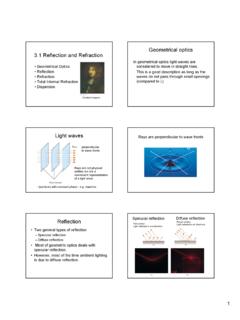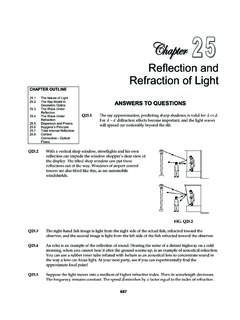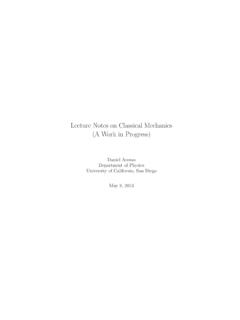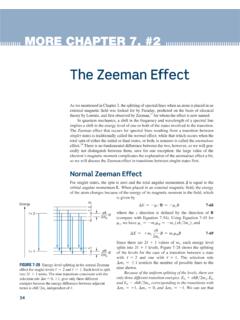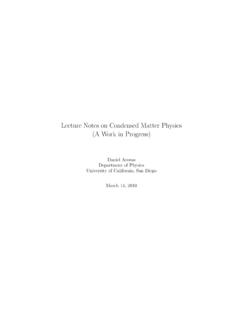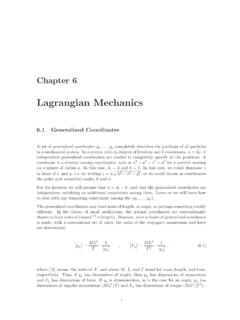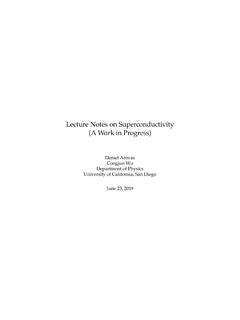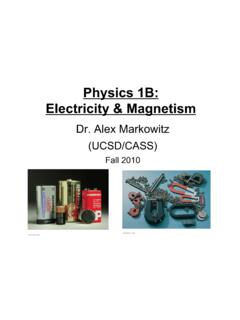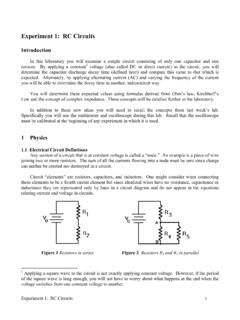Transcription of Temperature coefficient of resistivity
1 Temperature coefficient of resistivity )]TT(1[oo + = )]TT(1[RRoo += T0 = reference Temperature = Temperature coefficient of resistivity , units of( C)-1 For Ag, Cu, Au, Al, W, Fe, Pt, Pb: values of are ~3-5 10-3 ( C)-1 Tslope = )]TT(1[RRoo +=Example: A platinum resistance thermometer uses thechange in R to measure Temperature . Suppose R0 = 50 at T0=20 C. for Pt is 10-3 ( C)-1 in this Temperature is R when T = C?R = 50 [1 + 10-3 ( C)-1 ( C)] = Temperature coefficient of resistivityExample: A platinum resistance thermometer has aresistance R0 = at T0=20 C. for Pt is 10-3( C)-1. The thermometer is immersed in a vesselcontaining melting tin, at which point R increases . What is the melting point of tin?
2 ]TT(1[RRoo += = 50 [1 + 10-3 ( C)-1 (T 20 C)] = [1 + 10-3 ( C)-1 (T 20 C)] = 10-3 ( C)-1 (T 20 C)212 C = T 20 CT = 232 CLight bulbsInert gas (typically Ar) is used to make sure that filamentis housed in an O-free environment to preventcombustion reaction between W and Sir Joseph Swan (1878) &American Thomas Edison (1879).Filament: The atoms are heated to4000 F to emit visible light. Tungsten isdurable under such extremetemperature conditions. (In weaker, lessdurable metals, atomic vibrations breakapart rigid structural bonds, so materialbecomes molten/liquid) tungsten filament: ~1 m long, but typical = (5x10-5m)2 = m2 = m (Table )R = L/A = ( m) (1m)/ m2 = Note: the resistivity value used above is valid only at atemperature of 20 C, so this derived value of R holds only forT=20 at T=2000 C, assuming a linear -T relation:For tungsten, = C = 0[1+ (T-T0)] = mR = L/A = 70.)
3 ( I suspect the -T relation in reality may not be strictlylinear over such a wide range of Temperature ; my guesswould be that the above value of may only be valid fortemperatures of tens to hundreds of C. In a few slides, wederive R from the power consumption and get R=144 ,which is probably more realistic) : SuperconductorsFor some materials, as temperaturedrops, resistance suddenly plummets to0 below some a current is set up, it can persistwithout any applied voltage becauseR 0!SuperconductorsApplications: Energy storage at power plants Super conducting distribution power lines couldeliminate resistive losses Superconducting magnets with much strongermagnetic fields than normal electromagnetsMore recently: As the field has advanced,materials with higher values of Tc get : Electrical Conduction: A Microscopic ViewRe-cap: Microscopic motions of charge carriers are random,v of ~ 106 m/s; collisions with moleculesWhen applied E-field is 0, net velocity is zero, and I=0e e EWhen an E-field is applied,electrons drift opposite to fieldlines.
4 Average motion is vdrift,typically tenths to a few mm/se EStronger applied E-fieldmeans larger vdrift,vdrift prop to EI prop to vdriftThe excess energy acquired by the electrons in thefield is lost to the atoms of the conductor during thecollisionThe energy given up to the atoms increases theirvibration and therefore the Temperature of theconductor Electrical Energy and PowerPower dissipated in a R is due to collisions of chargecarriers with the lattice. Electrical potential energy isconverted to thermal energy in the resistor--a light bulb filament thus glowsglowsor toaster filaments give off heat (and turn orange) power = work / time = q V/ tP = I * VP= I2 RP = V2 / RUNITS:P = I V = Amp * Volt = C/s * J/C = J/s = WATTP ower dissipated in a resistorExample: A typical household incandescentlightbulb is connected to a 120V outlet.
5 The poweroutput is 100 Watts. What's the current through thebulb? What s R of the filament? V = 120 V (rel. to ground)P=I V I = P/ V = 100W/120V = AP = V2 / R ----> R = V2 / P = (120V)2 / 100 W =144 Note -- a few slides earlier, we d estimated the typical resistance of a tungstenlight bulb filament at 2000 C -- that estimate of ~70 assumed for simplicity aconstant coefficient of resistivity from 20 C to 2000 C, which might not be thecase in reality. If the actual value of increases as T increases, then thedependence of on T will also be non-linearElectric RangeA heating element in an electric range is rated at2000 W. Find the current required if the voltage is240 V. Find the resistance of the heating = I V I = P/ V = 2000W/240V = AR = V2 / P = (240V)2/2000W = Cost of electrical power1 kilowatt-hour = 1000 W * 1 hour = 1000 J/s (3600s) = costs about $ , typicallyHow much does it cost to keep a single 100W light bulb on for 24hours?
6 (100W)*24hrs = 2400 W-hr = *$ = $ TransmissionTransmitting electrical power is done much more efficientlyat higher voltages due to the desire to minimize (I2R) power transmission to a small community which is 100mi from the power plant and which consumes power at a rate of10 other words, the generating station needs to supply whateverpower it takes such that Preq =10 MW arrives at the end user(compensating for I2R losses): Pgenerated = Ploss + PreqConsider three cases:A: V=2000 V; I=5000 A (Preq = IV = 107 W)B: V=20000 V; I=500 A (Preq = IV = 107 W)C: V=200000 V; I=50 A (Preq = IV = 107 W) power TransmissionResistance/length = / of transmission line = 100 mile = 528000 R = .A: Ploss = I2R = (5000A)2( ) = MWPgenerated = Ploss + Preq = MW + 10 MW = MWEfficiency of transmission = Preq / Pgenerated = : Ploss = I2R = (500A)2( ) = MWPgenerated = Ploss + Preq = MW + 10 MW = MWEfficiency of transmission = Preq / Pgenerated = 43%C: Ploss = I2R = (50A)2( ) = MWPgenerated = Ploss + Preq = MW + 10 MW = MWEfficiency of transmission = Preq / Pgenerated = (most reasonable)Lower current during transmission yields a reduction in Ploss!
7 You can do the same exercise for local distribution lines(assume Preq = MW), which are usually a few miles long(so the value of R is ~ a few) and need to distribute powerfrom substations to local neighborhoods at a voltage of atleast a few thousand volts (keeping currents under ~30A,roughly) to have a transmission efficiency above ~90%.Household circuitsCircuits are in parallel. All deviceshave same potential. If one devicefails, others will continue to work atrequired potential. V is 120 V above ground potentialHeavy-duty appliances (electricranges, clothes dryers) require 240V. power co. supplies a line whichis 120V BELOW ground potential soTOTAL potential drop is 240 VCircuit breakers or fuses areconnected in : melt when I gets toohigh, opening the circuitCircuit breakers: opens circuitwithout melting.
8 So they canbe circuit breakers useelectromagnets, to bediscussed in future chaptersExample: Consider a microwave oven, a toaster, and aspace heater, all operating at 120 V:Toaster: 1000 WMicrowave: 800 WHeater: 1300 WHow much current does each draw? I = P/ VToaster: I = 1000W/120V = : I = 800W/120V = : I = 1300W/120V = ATotal current (if all operated simultaneously)= A(So the breaker should be able to handle this level ofcurrent, otherwise it'll trip)Electrical SafetyRskin(dry) ~ 105 So for V = 10,000V:I = V/R = 10,000V/105 = = Rskin(wet) is much, much lower, ~103 :So in this case, when V = 120V, I is also ~ A = : Direct-Current CircuitsEMFR esistors in Series & in ParallelKirchoff s Junction & Loop Rules forcomplex circuitsRC : Sources of EMFIn a closed circuit, the sourceof EMF is what drives andsustains the = work done per charge:Joule / Coulomb = VoltAssume internal resistance rof battery is , = IRRADBCFrom A to B.
9 Potentialincreases by V = + From B to A: Potentialdecreases by V = .From C to D: Potentialdecreases by V = IR= If circuit is grounded: V at points A & D will A to B: Potentialincreases by V = + From B to A: Potentialdecreases by V = .From C to D: Potentialdecreases by V = IR= Why is this useful?The middle voltage can be 'tailored' toany voltage we desire (between 0 and ) by adjusting R1 and R2! R1R2 BACDEFA B C D E FV0 IR1IR2A battery s internalresistance rIn reality, there will be some Vlost within the battery due tointernal resistance: IrTerminal Voltage actuallysupplied: V = Ir.
